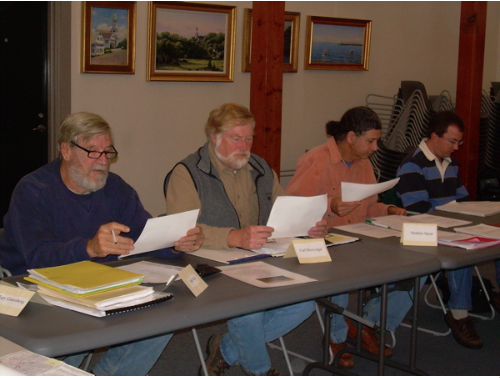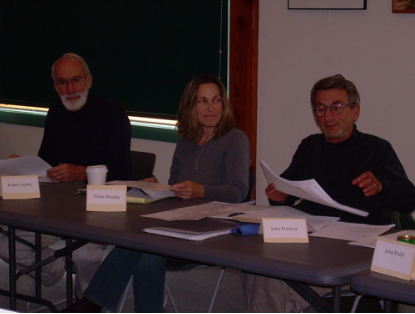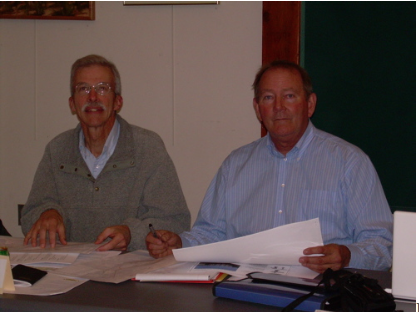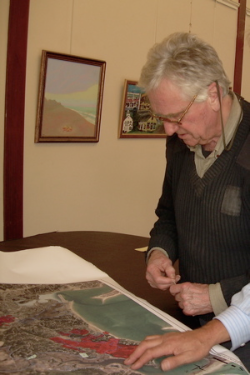By the end of 2007, the Herring River Technical Committee had completed its task of producing a Conceptual Restoration Plan and creating a second Memorandum of Understanding (MOU II) which linked the participants in the restoration planning process. A new committee, the HERRING RIVER RESTORATION COMMITTEE was also created by the MOU II. The Towns of Wellfleet and Truro, and the Cape Cod National Seashore were referred to as Entities, with their representatives carrying veto power. Four participating agencies necessary for restoration planning were referred to as Cooperating Agencies: USDA's Natural Resources Conservation Service; MA Coastal Zone Management; U.S. Fish and Wildlife Service and NOAA Wetlands Restoration Program. These representatives will work together, by consensus, to plan the proposed restoration.
TO REVIEW THE ENTIRE APPROVED CONCEPTUAL RESTORATION PLAN, PLEASE GO TO THE LINK BELOW:
http://www.nps.gov/caco/naturescience/herring-river-conceptual-restoration-plan.htm
AGENDA FOR NEXT MEETING
HERRING RIVER RESTORATION COMMITTEE July 15 Wellfleet Senior Center 10 AM
I. Update on Hydrodynamic modeling Kirk Busman Woods hole group II. Discussion of tasks for EIS Phase 2 contract III. Planning for First Public Scoping Meeting, August 14 IV. Review of revised CYCC Grading plans, Louis Berger Group V. Update on NEPA/ MEPA filings VI. Discussion of 6/24/08 MA Historic Commission response letter VII. Update on Friends of Herring River organizing VIII. New business IX. Next meeting
Previous Agenda
Herring River Restoration Committee
May 21, 2008
Agenda
I. Status of Hydrodynamic Modeling
II. Status of NOI filing for NEPA
A. Project Notification Form for historical and archaeological review
III Status of Special Project Review for MEPA
IV Status of planning for public scoping sessions this summer
V Status of Berger work
VI. Out come Of CYCC charrette A. formation of smaller working group with CYCC B. Formation of Third Party group
VII. Discussion of ACOE involvement in project
VIII adjourn
Most Recent Minutes of the Herring River Restoration Committee
Minutes of Herring River Restoration Committee CCNS Headquarters 3 April 2008 Members attending: Gary Joseph, Chairman (Wellfleet), Eric Derleth (US FWS), Charleen Greenhalgh (Truro), Steve Spear (NRCS), Steve Block (NOAA), Tim Smith (MCZM-MWRP), John Portnoy (CCNS) Others attending: Carrie Phillips (CCNS), Davis McGowan (DCR), Helen M. Wilson, John Riehl. Craig Wood, Spence Smith and Chris Gajeski represented The Berger Group. Minutes of the 21 February meeting were accepted unanimously after correcting the meeting location to Seashore Headquarters. A charrette at the Chequesset Yacht and Country Club is planned for 7 May from 10 AM to 3 PM to brainstorm alternatives to fund golf-course relocation out of the Herring River flood plain. The HRRC discussed whom should attend. John Riehl suggested that Ivan Ace, a CYCC member and past Friend of CCNS, be invited. A new option of filling existing fairways, instead of relocating them, was discussed. One benefit is that this plan preserves the CYCC undeveloped land, a valuable asset; however, it may be premature to include this option in the 7 May meeting. Phillips noted that the fill alternative will have to be considered in the EIS/EIR, but the charrette should focus on relocation, with filling only considered with respect to potential limits of funding. Derleth and Joseph agreed. Spear and Riehl suggested that we need to reconsider diking off Mill Creek, if all else fails to relocate the golf fairways. McGowan went over the CYCC charrette agenda, which will end with the identification of specific tasks and due dates. We discussed the "Yellow-book" appraisal of the 25-acre CYCC property, at only $400,000, much less than the anticipated $2.4-million value that led Wellfleet voters to promise a $1.2-million contribution from the Land Bank. Fate of the $1.2 million is now uncertain, but Joseph will follow up with Assistant Town Administrator Peterson. Greenhalgh suggested that the HRRC seek clarification from the town attorney on whether these funds can be re-authorized for use on some other aspect of the project. It was moved (Derleth), seconded (Block) and unanimously voted that the Chair write to Wellfleet administration requesting information regarding future use of the $1.2 million. Portnoy will draft some specific questions for HRRC review. Hydrodynamic modeling by the Woods Hole Group continues per their contract with some delays, per T. Smith. The HRRC discussed and rejected the idea of experimentally opening the dike's single sluice gate for model calibration. SERO regulatory meeting, 6 March. T. Smith presented the project. We received good support from all of the regulatory agencies. G. Joseph requested preparation of a brief presentation on project objectives, scope and progress for public programs. Portnoy will put this together and forward to the HRRC for comment. NOI and scoping for NEPA. Phillips expects it will take 6-12 weeks to get it published in the Federal Register after leaving the Park. EIS public scoping is planned for 2 PM on 14 August, including State MEPA, and at 7 PM on 24 September, both at the Wellfleet Senior Center. The comment period will be 60 days. Portnoy will check with the Cape Cod Commission on whether they are required to hold public scoping for a DRI, and, if so, whether they want to combine theirs with ours. Berger Group. Craig Wood, Spence Smith and Chris Gajeski represented Berger. They will provide their meeting notes from today. The HRRC gave Wood permission to contact Lindsay Gillham, project manager for EIS preparation under NPS funding, directly with questions, but asked that the Committee be copied on all correspondence. S. Smith noted that Berger will keep its own administrative record of their involvement of the project; this record is a deliverable at the end of the project. Re the towns' administrative record, H. Wilson noted that the HRRC is accountable to both Truro and Wellfleet for minutes and any emails pertinent to decision-making. Points of contact for Berger will be C. Phillips for NEPA and T. Smith for MEPA. We went over Berger's schedule. It was noted that Chapter 1 of the EIS requires input from public scoping, so it cannot be completed by Berger under the current contract schedule. The HRRC will look over examples of style and structure for Chapter 1 and provide Berger with a model to follow. A draft outline for this chapter, including project purpose, need, objectives and impact topics, is being routed for HRRC review by Portnoy, for transmittal asap to Berger. Wood urged that we begin contact with Mass. Historical Commission soon for MEPA, and after the NOI is published for NEPA; he will have Berger's archaeologist contact MHC. S. Spear said to include the Wampanoag, typically at time of public scoping. Berger will notify MNHESP, although prior meetings of this office with HRRC members, and at the 6 March SERO meeting, were noted. Wood advised that restoration of tides would increase the FEMA 100-year flood elevation upstream of the dike; however, it was noted that effects should be limited to already existing wetlands. This issue needs to be addressed in the EIS/EIR. The MWRP has asked Berger to prepare a proposal for the assessment of filling low fairways in the CYCC, recognizing that this alternative must be considered in the EIS/EIR. Spear suggested that fill volumes be computed for each 1-foot increment in final elevation. Our next meeting is planned for 10 AM on 21 May at Wellfleet Senior Center. Respectfully submitted, John Portnoy








